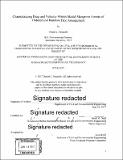| dc.contributor.advisor | Heidi M. Nepf. | en_US |
| dc.contributor.author | Pasquale, Daniel L. (Daniel Louis) | en_US |
| dc.contributor.other | Massachusetts Institute of Technology. Department of Civil and Environmental Engineering. | en_US |
| dc.date.accessioned | 2017-09-15T15:38:02Z | |
| dc.date.available | 2017-09-15T15:38:02Z | |
| dc.date.copyright | 2017 | en_US |
| dc.date.issued | 2017 | en_US |
| dc.identifier.uri | http://hdl.handle.net/1721.1/111525 | |
| dc.description | Thesis: M. Eng., Massachusetts Institute of Technology, Department of Civil and Environmental Engineering, 2017. | en_US |
| dc.description | Cataloged from PDF version of thesis. | en_US |
| dc.description | Includes bibliographical references (page 50). | en_US |
| dc.description.abstract | Changes in velocity and drag force on model mangrove trees within 13 different simulated mangrove forest segments in a flume were investigated. The simulated forests were composed of 1/12 scale model Rhizophora mangrove trees placed at three densities: low (3.42 trees/m²), medium (6.34 trees/m²), and high (9.27 trees/m²). For the low tree density cases, one forest with ordered tree placement and six forests with random tree placement were studied. For the medium and high tree density cases, one ordered tree arrangement and two random tree arrangements were studied. Spatial arrangements of the forests were described using the mean distance to nearest neighbor (NN) for all trees in a particular forest. The forest arrangements were also described using the spatial aggregation index developed by Clark and Evans. [9] For forests of ordered tree arrangement, depth-averaged velocity was found to decrease from the leading edge to the trailing edge of the forest segment at each density, and the reduction in velocity moving through the forest was greater for denser forests. Vertical profiles of velocity show that a region of high velocity developed above the root zone when moving from the leading edge to the trailing edge of the forest. This effect was more pronounced in the forests with random tree arrangement and low mean NN distance. For all spatial arrangements, the drag force acting on an individual tree decreased from the leading edge to the trailing edge of the forest. Larger decreases in drag force occurred within denser forests. Mangrove tree drag coefficient values were found to be similar or slightly higher for trees within forests of random arrangement compared to trees within forests of ordered arrangement, but further study examining a greater amount of random tree arrangements is needed. This study describes changes in the vulnerability of a mangrove forest that could occur if mangrove trees were removed from the forest by natural or human causes. | en_US |
| dc.description.statementofresponsibility | by Daniel L. Pasquale. | en_US |
| dc.format.extent | 98 pages | en_US |
| dc.language.iso | eng | en_US |
| dc.publisher | Massachusetts Institute of Technology | en_US |
| dc.rights | MIT theses are protected by copyright. They may be viewed, downloaded, or printed from this source but further reproduction or distribution in any format is prohibited without written permission. | en_US |
| dc.rights.uri | http://dspace.mit.edu/handle/1721.1/7582 | en_US |
| dc.subject | Civil and Environmental Engineering. | en_US |
| dc.title | Characterizing drag and velocity within model mangrove forests of ordered and random tree arrangement | en_US |
| dc.type | Thesis | en_US |
| dc.description.degree | M. Eng. | en_US |
| dc.contributor.department | Massachusetts Institute of Technology. Department of Civil and Environmental Engineering | |
| dc.identifier.oclc | 1003324365 | en_US |
